WINDOORS Inc. Case Study: Handling and Transport Method Analysis
VerifiedAdded on 2022/08/29
|12
|2547
|22
Case Study
AI Summary
This case study examines WINDOORS Inc.'s current transport and handling methods for its vinyl windows, patio doors, and entry doors, focusing on its expansion into Western Canada. It analyzes the costs and efficiencies of various transport options, including for-hire carriers, railway-owned box cars (CN and CPR), and rail-intermodal transport. The analysis considers factors such as shipment value, freight costs, time costs, product safety, and green logistics. The case study recommends the use of railway-owned box cars with CPR due to lower costs and faster transport times. It also suggests incorporating technology for loss monitoring and exploring third-party logistics to improve efficiency and reduce risks. The study emphasizes the importance of green logistics and improving loading/off-loading systems to minimize product damage and environmental impact.
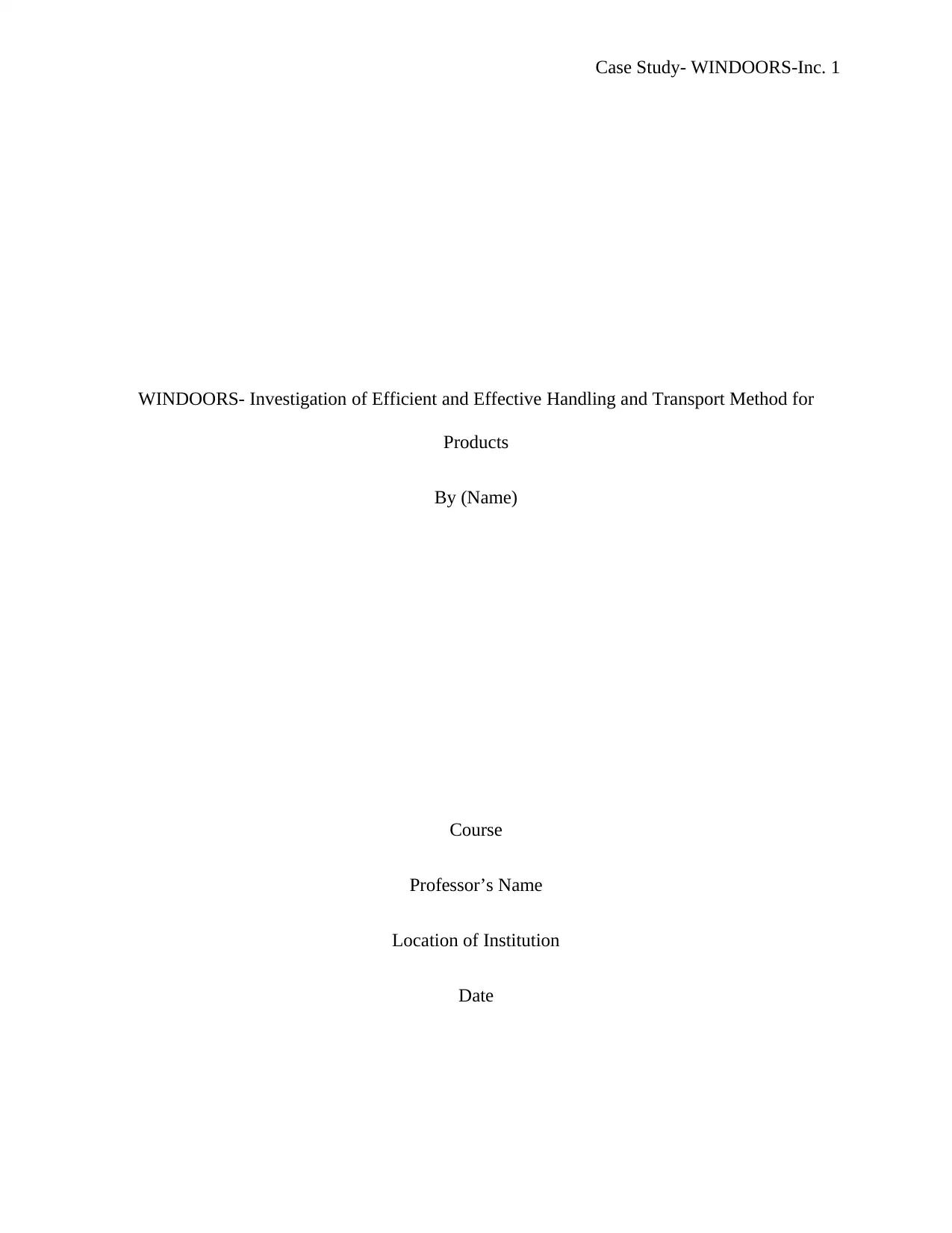
Case Study- WINDOORS-Inc. 1
WINDOORS- Investigation of Efficient and Effective Handling and Transport Method for
Products
By (Name)
Course
Professor’s Name
Location of Institution
Date
WINDOORS- Investigation of Efficient and Effective Handling and Transport Method for
Products
By (Name)
Course
Professor’s Name
Location of Institution
Date
Paraphrase This Document
Need a fresh take? Get an instant paraphrase of this document with our AI Paraphraser
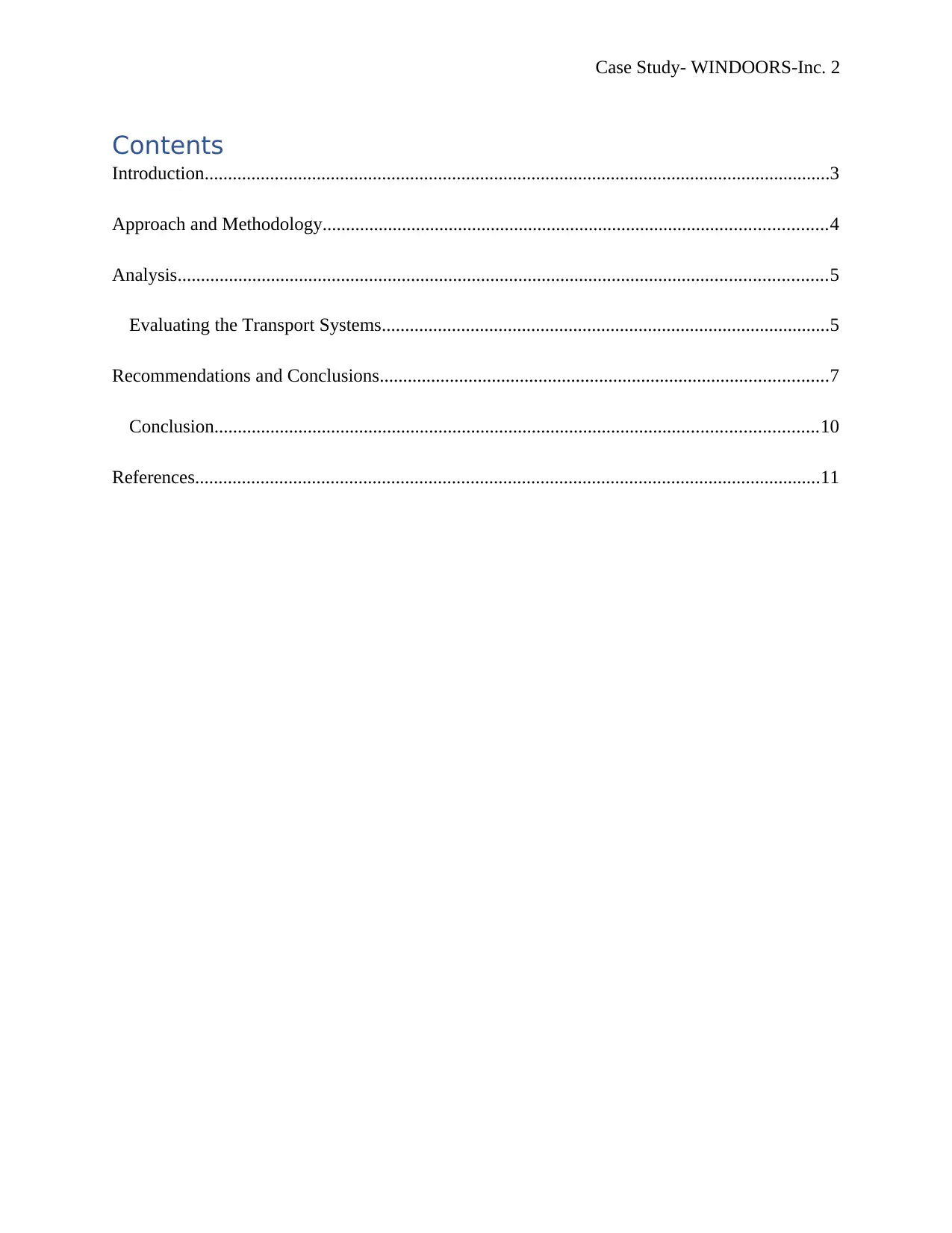
Case Study- WINDOORS-Inc. 2
Contents
Introduction......................................................................................................................................3
Approach and Methodology............................................................................................................4
Analysis...........................................................................................................................................5
Evaluating the Transport Systems................................................................................................5
Recommendations and Conclusions................................................................................................7
Conclusion.................................................................................................................................10
References......................................................................................................................................11
Contents
Introduction......................................................................................................................................3
Approach and Methodology............................................................................................................4
Analysis...........................................................................................................................................5
Evaluating the Transport Systems................................................................................................5
Recommendations and Conclusions................................................................................................7
Conclusion.................................................................................................................................10
References......................................................................................................................................11
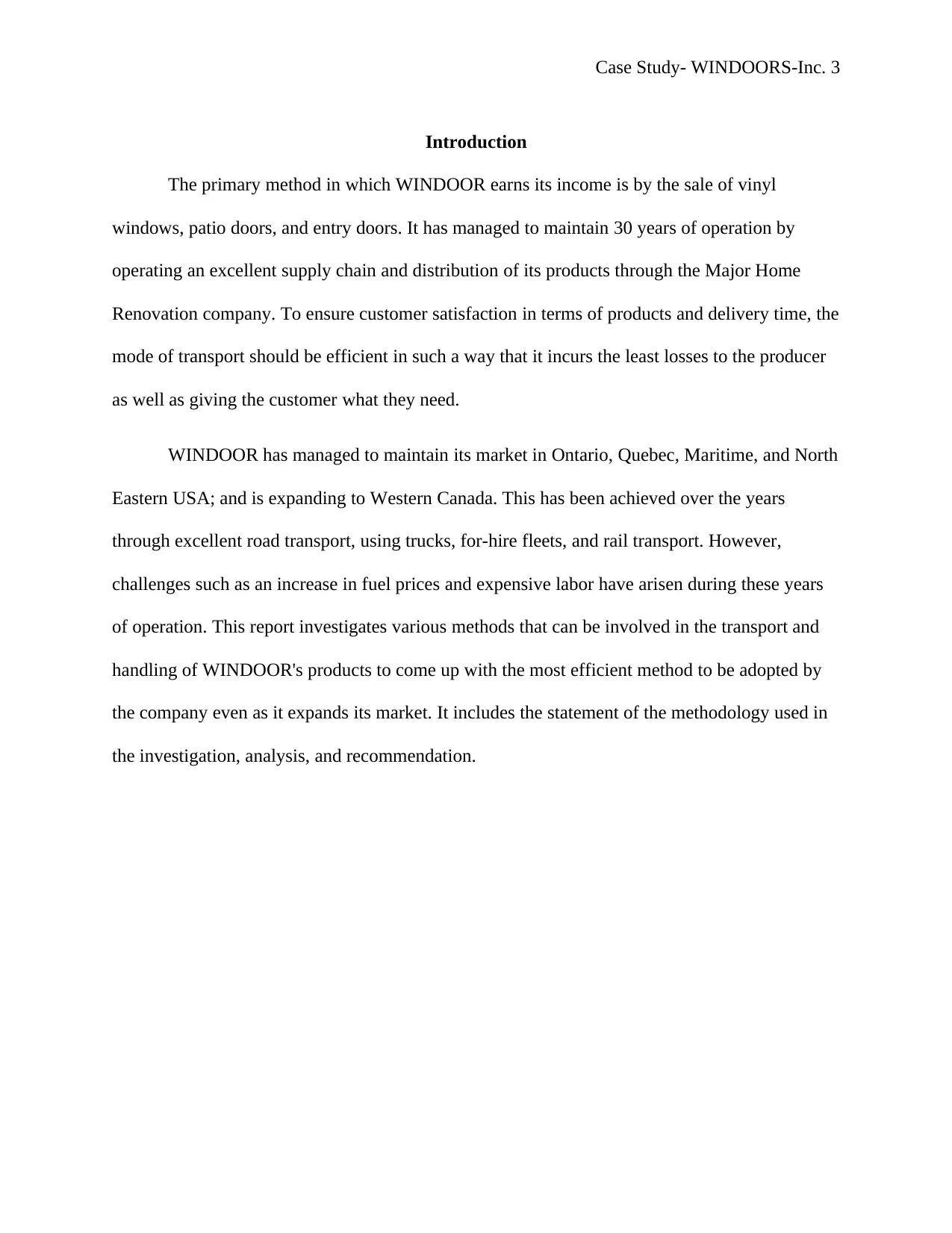
Case Study- WINDOORS-Inc. 3
Introduction
The primary method in which WINDOOR earns its income is by the sale of vinyl
windows, patio doors, and entry doors. It has managed to maintain 30 years of operation by
operating an excellent supply chain and distribution of its products through the Major Home
Renovation company. To ensure customer satisfaction in terms of products and delivery time, the
mode of transport should be efficient in such a way that it incurs the least losses to the producer
as well as giving the customer what they need.
WINDOOR has managed to maintain its market in Ontario, Quebec, Maritime, and North
Eastern USA; and is expanding to Western Canada. This has been achieved over the years
through excellent road transport, using trucks, for-hire fleets, and rail transport. However,
challenges such as an increase in fuel prices and expensive labor have arisen during these years
of operation. This report investigates various methods that can be involved in the transport and
handling of WINDOOR's products to come up with the most efficient method to be adopted by
the company even as it expands its market. It includes the statement of the methodology used in
the investigation, analysis, and recommendation.
Introduction
The primary method in which WINDOOR earns its income is by the sale of vinyl
windows, patio doors, and entry doors. It has managed to maintain 30 years of operation by
operating an excellent supply chain and distribution of its products through the Major Home
Renovation company. To ensure customer satisfaction in terms of products and delivery time, the
mode of transport should be efficient in such a way that it incurs the least losses to the producer
as well as giving the customer what they need.
WINDOOR has managed to maintain its market in Ontario, Quebec, Maritime, and North
Eastern USA; and is expanding to Western Canada. This has been achieved over the years
through excellent road transport, using trucks, for-hire fleets, and rail transport. However,
challenges such as an increase in fuel prices and expensive labor have arisen during these years
of operation. This report investigates various methods that can be involved in the transport and
handling of WINDOOR's products to come up with the most efficient method to be adopted by
the company even as it expands its market. It includes the statement of the methodology used in
the investigation, analysis, and recommendation.
⊘ This is a preview!⊘
Do you want full access?
Subscribe today to unlock all pages.

Trusted by 1+ million students worldwide
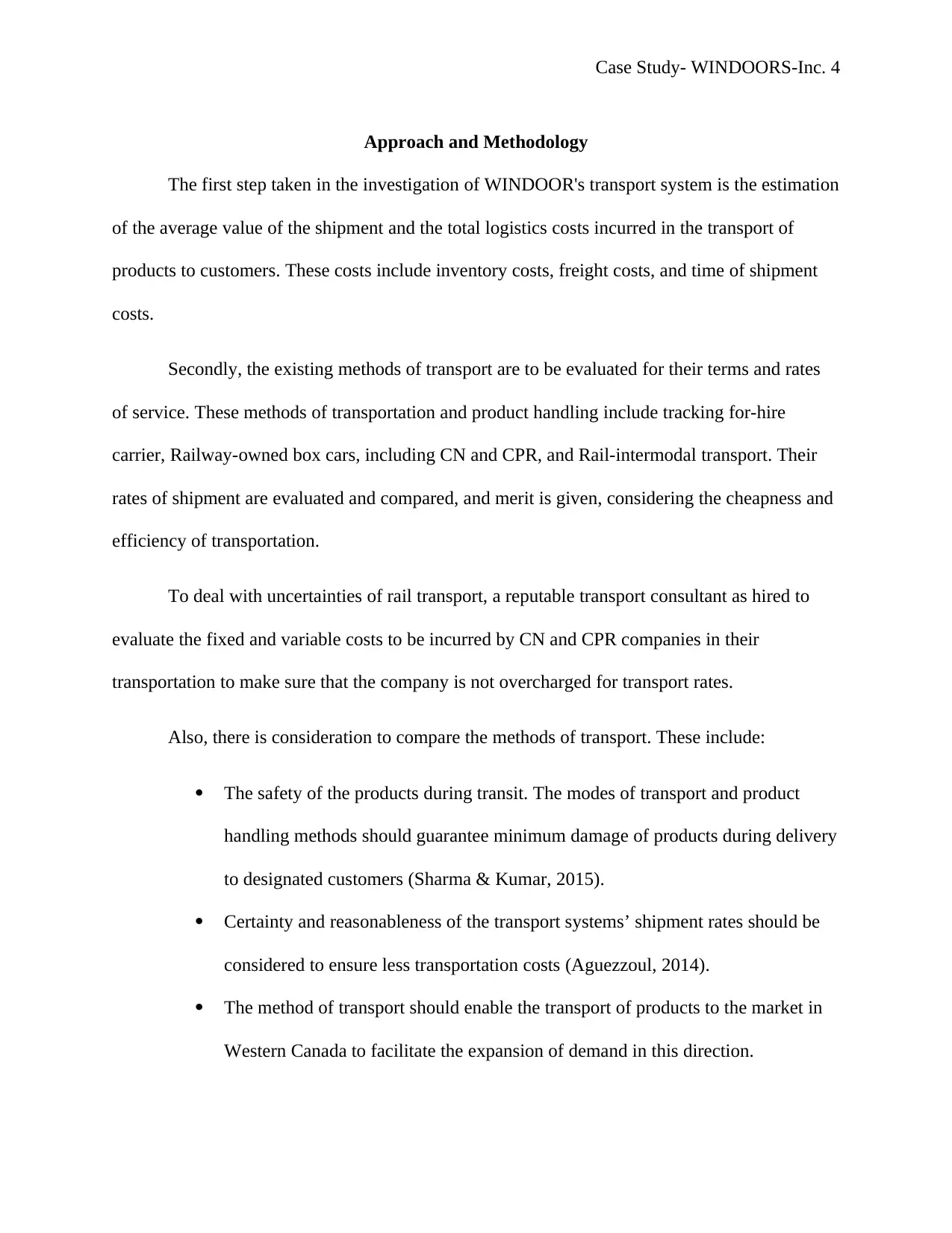
Case Study- WINDOORS-Inc. 4
Approach and Methodology
The first step taken in the investigation of WINDOOR's transport system is the estimation
of the average value of the shipment and the total logistics costs incurred in the transport of
products to customers. These costs include inventory costs, freight costs, and time of shipment
costs.
Secondly, the existing methods of transport are to be evaluated for their terms and rates
of service. These methods of transportation and product handling include tracking for-hire
carrier, Railway-owned box cars, including CN and CPR, and Rail-intermodal transport. Their
rates of shipment are evaluated and compared, and merit is given, considering the cheapness and
efficiency of transportation.
To deal with uncertainties of rail transport, a reputable transport consultant as hired to
evaluate the fixed and variable costs to be incurred by CN and CPR companies in their
transportation to make sure that the company is not overcharged for transport rates.
Also, there is consideration to compare the methods of transport. These include:
The safety of the products during transit. The modes of transport and product
handling methods should guarantee minimum damage of products during delivery
to designated customers (Sharma & Kumar, 2015).
Certainty and reasonableness of the transport systems’ shipment rates should be
considered to ensure less transportation costs (Aguezzoul, 2014).
The method of transport should enable the transport of products to the market in
Western Canada to facilitate the expansion of demand in this direction.
Approach and Methodology
The first step taken in the investigation of WINDOOR's transport system is the estimation
of the average value of the shipment and the total logistics costs incurred in the transport of
products to customers. These costs include inventory costs, freight costs, and time of shipment
costs.
Secondly, the existing methods of transport are to be evaluated for their terms and rates
of service. These methods of transportation and product handling include tracking for-hire
carrier, Railway-owned box cars, including CN and CPR, and Rail-intermodal transport. Their
rates of shipment are evaluated and compared, and merit is given, considering the cheapness and
efficiency of transportation.
To deal with uncertainties of rail transport, a reputable transport consultant as hired to
evaluate the fixed and variable costs to be incurred by CN and CPR companies in their
transportation to make sure that the company is not overcharged for transport rates.
Also, there is consideration to compare the methods of transport. These include:
The safety of the products during transit. The modes of transport and product
handling methods should guarantee minimum damage of products during delivery
to designated customers (Sharma & Kumar, 2015).
Certainty and reasonableness of the transport systems’ shipment rates should be
considered to ensure less transportation costs (Aguezzoul, 2014).
The method of transport should enable the transport of products to the market in
Western Canada to facilitate the expansion of demand in this direction.
Paraphrase This Document
Need a fresh take? Get an instant paraphrase of this document with our AI Paraphraser
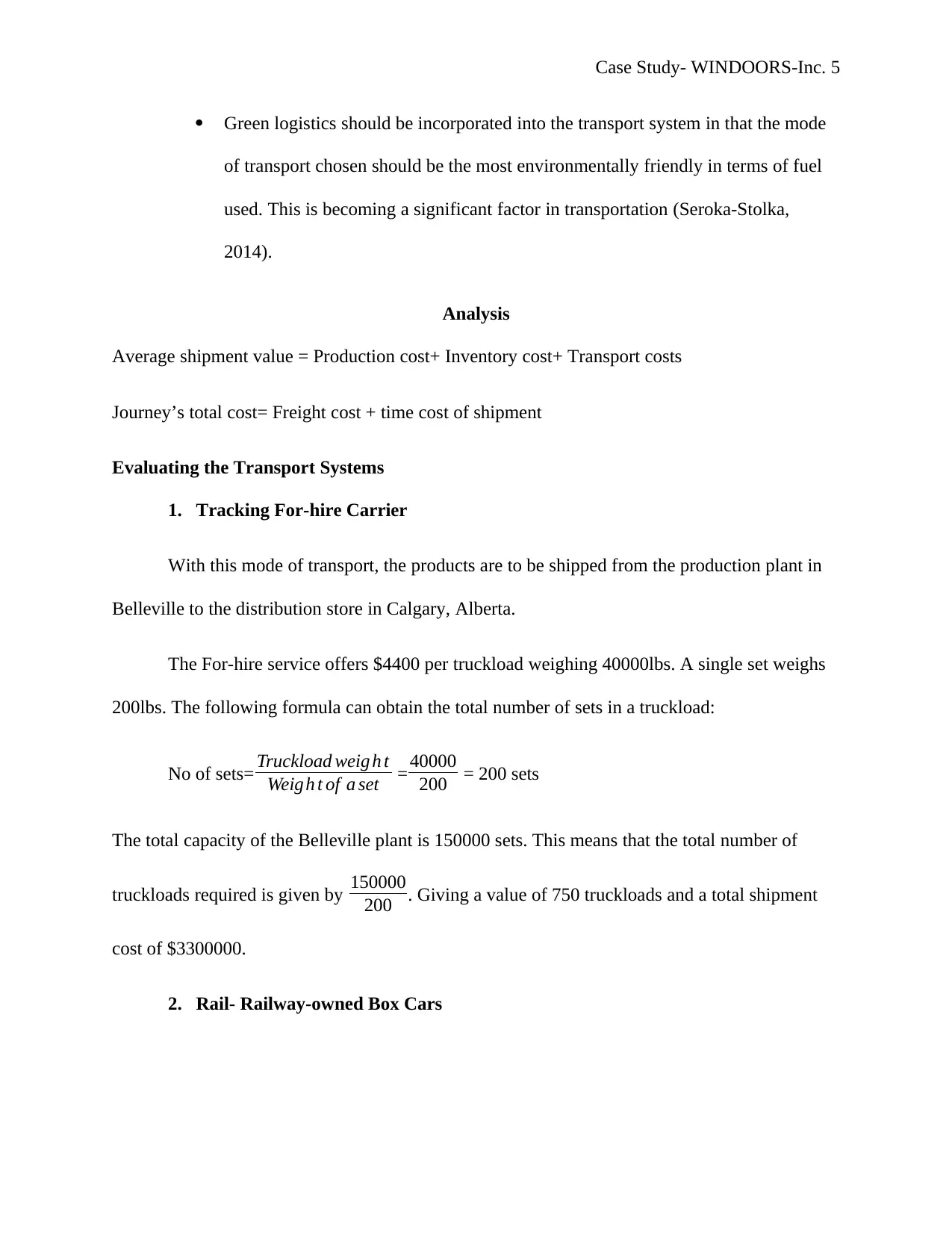
Case Study- WINDOORS-Inc. 5
Green logistics should be incorporated into the transport system in that the mode
of transport chosen should be the most environmentally friendly in terms of fuel
used. This is becoming a significant factor in transportation (Seroka-Stolka,
2014).
Analysis
Average shipment value = Production cost+ Inventory cost+ Transport costs
Journey’s total cost= Freight cost + time cost of shipment
Evaluating the Transport Systems
1. Tracking For-hire Carrier
With this mode of transport, the products are to be shipped from the production plant in
Belleville to the distribution store in Calgary, Alberta.
The For-hire service offers $4400 per truckload weighing 40000lbs. A single set weighs
200lbs. The following formula can obtain the total number of sets in a truckload:
No of sets= Truckload weig h t
Weigh t of a set = 40000
200 = 200 sets
The total capacity of the Belleville plant is 150000 sets. This means that the total number of
truckloads required is given by 150000
200 . Giving a value of 750 truckloads and a total shipment
cost of $3300000.
2. Rail- Railway-owned Box Cars
Green logistics should be incorporated into the transport system in that the mode
of transport chosen should be the most environmentally friendly in terms of fuel
used. This is becoming a significant factor in transportation (Seroka-Stolka,
2014).
Analysis
Average shipment value = Production cost+ Inventory cost+ Transport costs
Journey’s total cost= Freight cost + time cost of shipment
Evaluating the Transport Systems
1. Tracking For-hire Carrier
With this mode of transport, the products are to be shipped from the production plant in
Belleville to the distribution store in Calgary, Alberta.
The For-hire service offers $4400 per truckload weighing 40000lbs. A single set weighs
200lbs. The following formula can obtain the total number of sets in a truckload:
No of sets= Truckload weig h t
Weigh t of a set = 40000
200 = 200 sets
The total capacity of the Belleville plant is 150000 sets. This means that the total number of
truckloads required is given by 150000
200 . Giving a value of 750 truckloads and a total shipment
cost of $3300000.
2. Rail- Railway-owned Box Cars
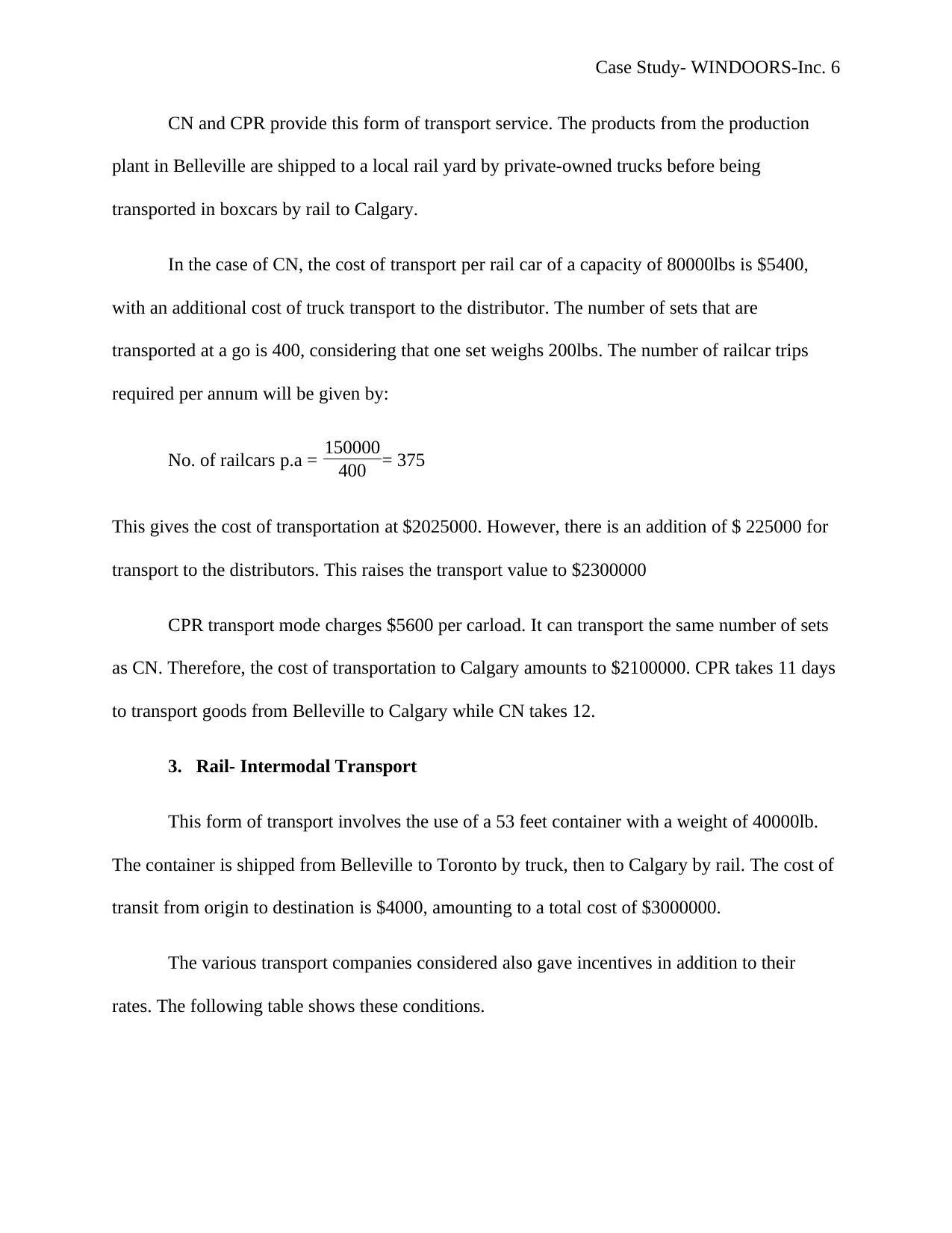
Case Study- WINDOORS-Inc. 6
CN and CPR provide this form of transport service. The products from the production
plant in Belleville are shipped to a local rail yard by private-owned trucks before being
transported in boxcars by rail to Calgary.
In the case of CN, the cost of transport per rail car of a capacity of 80000lbs is $5400,
with an additional cost of truck transport to the distributor. The number of sets that are
transported at a go is 400, considering that one set weighs 200lbs. The number of railcar trips
required per annum will be given by:
No. of railcars p.a = 150000
400 = 375
This gives the cost of transportation at $2025000. However, there is an addition of $ 225000 for
transport to the distributors. This raises the transport value to $2300000
CPR transport mode charges $5600 per carload. It can transport the same number of sets
as CN. Therefore, the cost of transportation to Calgary amounts to $2100000. CPR takes 11 days
to transport goods from Belleville to Calgary while CN takes 12.
3. Rail- Intermodal Transport
This form of transport involves the use of a 53 feet container with a weight of 40000lb.
The container is shipped from Belleville to Toronto by truck, then to Calgary by rail. The cost of
transit from origin to destination is $4000, amounting to a total cost of $3000000.
The various transport companies considered also gave incentives in addition to their
rates. The following table shows these conditions.
CN and CPR provide this form of transport service. The products from the production
plant in Belleville are shipped to a local rail yard by private-owned trucks before being
transported in boxcars by rail to Calgary.
In the case of CN, the cost of transport per rail car of a capacity of 80000lbs is $5400,
with an additional cost of truck transport to the distributor. The number of sets that are
transported at a go is 400, considering that one set weighs 200lbs. The number of railcar trips
required per annum will be given by:
No. of railcars p.a = 150000
400 = 375
This gives the cost of transportation at $2025000. However, there is an addition of $ 225000 for
transport to the distributors. This raises the transport value to $2300000
CPR transport mode charges $5600 per carload. It can transport the same number of sets
as CN. Therefore, the cost of transportation to Calgary amounts to $2100000. CPR takes 11 days
to transport goods from Belleville to Calgary while CN takes 12.
3. Rail- Intermodal Transport
This form of transport involves the use of a 53 feet container with a weight of 40000lb.
The container is shipped from Belleville to Toronto by truck, then to Calgary by rail. The cost of
transit from origin to destination is $4000, amounting to a total cost of $3000000.
The various transport companies considered also gave incentives in addition to their
rates. The following table shows these conditions.
⊘ This is a preview!⊘
Do you want full access?
Subscribe today to unlock all pages.

Trusted by 1+ million students worldwide
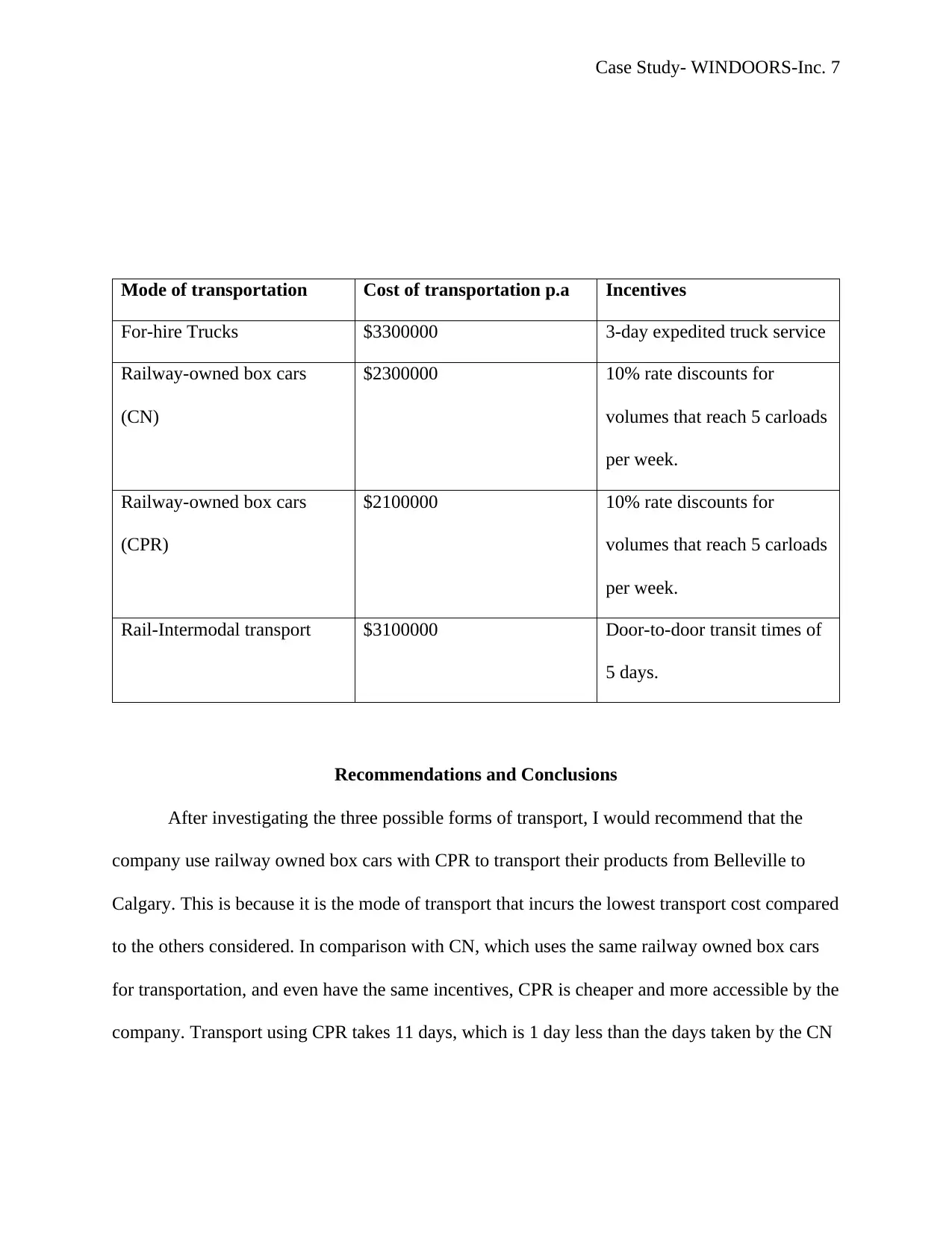
Case Study- WINDOORS-Inc. 7
Mode of transportation Cost of transportation p.a Incentives
For-hire Trucks $3300000 3-day expedited truck service
Railway-owned box cars
(CN)
$2300000 10% rate discounts for
volumes that reach 5 carloads
per week.
Railway-owned box cars
(CPR)
$2100000 10% rate discounts for
volumes that reach 5 carloads
per week.
Rail-Intermodal transport $3100000 Door-to-door transit times of
5 days.
Recommendations and Conclusions
After investigating the three possible forms of transport, I would recommend that the
company use railway owned box cars with CPR to transport their products from Belleville to
Calgary. This is because it is the mode of transport that incurs the lowest transport cost compared
to the others considered. In comparison with CN, which uses the same railway owned box cars
for transportation, and even have the same incentives, CPR is cheaper and more accessible by the
company. Transport using CPR takes 11 days, which is 1 day less than the days taken by the CN
Mode of transportation Cost of transportation p.a Incentives
For-hire Trucks $3300000 3-day expedited truck service
Railway-owned box cars
(CN)
$2300000 10% rate discounts for
volumes that reach 5 carloads
per week.
Railway-owned box cars
(CPR)
$2100000 10% rate discounts for
volumes that reach 5 carloads
per week.
Rail-Intermodal transport $3100000 Door-to-door transit times of
5 days.
Recommendations and Conclusions
After investigating the three possible forms of transport, I would recommend that the
company use railway owned box cars with CPR to transport their products from Belleville to
Calgary. This is because it is the mode of transport that incurs the lowest transport cost compared
to the others considered. In comparison with CN, which uses the same railway owned box cars
for transportation, and even have the same incentives, CPR is cheaper and more accessible by the
company. Transport using CPR takes 11 days, which is 1 day less than the days taken by the CN
Paraphrase This Document
Need a fresh take? Get an instant paraphrase of this document with our AI Paraphraser
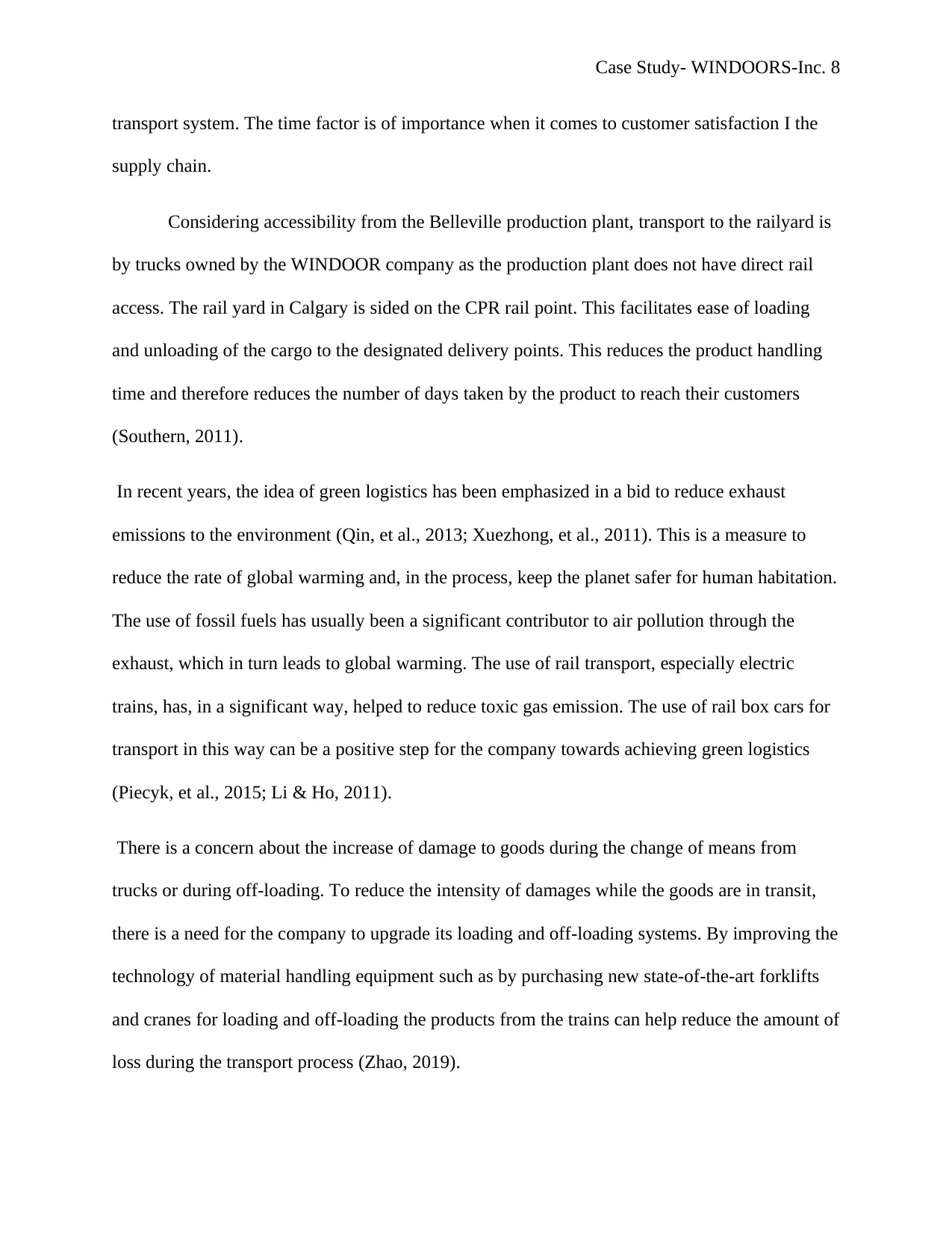
Case Study- WINDOORS-Inc. 8
transport system. The time factor is of importance when it comes to customer satisfaction I the
supply chain.
Considering accessibility from the Belleville production plant, transport to the railyard is
by trucks owned by the WINDOOR company as the production plant does not have direct rail
access. The rail yard in Calgary is sided on the CPR rail point. This facilitates ease of loading
and unloading of the cargo to the designated delivery points. This reduces the product handling
time and therefore reduces the number of days taken by the product to reach their customers
(Southern, 2011).
In recent years, the idea of green logistics has been emphasized in a bid to reduce exhaust
emissions to the environment (Qin, et al., 2013; Xuezhong, et al., 2011). This is a measure to
reduce the rate of global warming and, in the process, keep the planet safer for human habitation.
The use of fossil fuels has usually been a significant contributor to air pollution through the
exhaust, which in turn leads to global warming. The use of rail transport, especially electric
trains, has, in a significant way, helped to reduce toxic gas emission. The use of rail box cars for
transport in this way can be a positive step for the company towards achieving green logistics
(Piecyk, et al., 2015; Li & Ho, 2011).
There is a concern about the increase of damage to goods during the change of means from
trucks or during off-loading. To reduce the intensity of damages while the goods are in transit,
there is a need for the company to upgrade its loading and off-loading systems. By improving the
technology of material handling equipment such as by purchasing new state-of-the-art forklifts
and cranes for loading and off-loading the products from the trains can help reduce the amount of
loss during the transport process (Zhao, 2019).
transport system. The time factor is of importance when it comes to customer satisfaction I the
supply chain.
Considering accessibility from the Belleville production plant, transport to the railyard is
by trucks owned by the WINDOOR company as the production plant does not have direct rail
access. The rail yard in Calgary is sided on the CPR rail point. This facilitates ease of loading
and unloading of the cargo to the designated delivery points. This reduces the product handling
time and therefore reduces the number of days taken by the product to reach their customers
(Southern, 2011).
In recent years, the idea of green logistics has been emphasized in a bid to reduce exhaust
emissions to the environment (Qin, et al., 2013; Xuezhong, et al., 2011). This is a measure to
reduce the rate of global warming and, in the process, keep the planet safer for human habitation.
The use of fossil fuels has usually been a significant contributor to air pollution through the
exhaust, which in turn leads to global warming. The use of rail transport, especially electric
trains, has, in a significant way, helped to reduce toxic gas emission. The use of rail box cars for
transport in this way can be a positive step for the company towards achieving green logistics
(Piecyk, et al., 2015; Li & Ho, 2011).
There is a concern about the increase of damage to goods during the change of means from
trucks or during off-loading. To reduce the intensity of damages while the goods are in transit,
there is a need for the company to upgrade its loading and off-loading systems. By improving the
technology of material handling equipment such as by purchasing new state-of-the-art forklifts
and cranes for loading and off-loading the products from the trains can help reduce the amount of
loss during the transport process (Zhao, 2019).
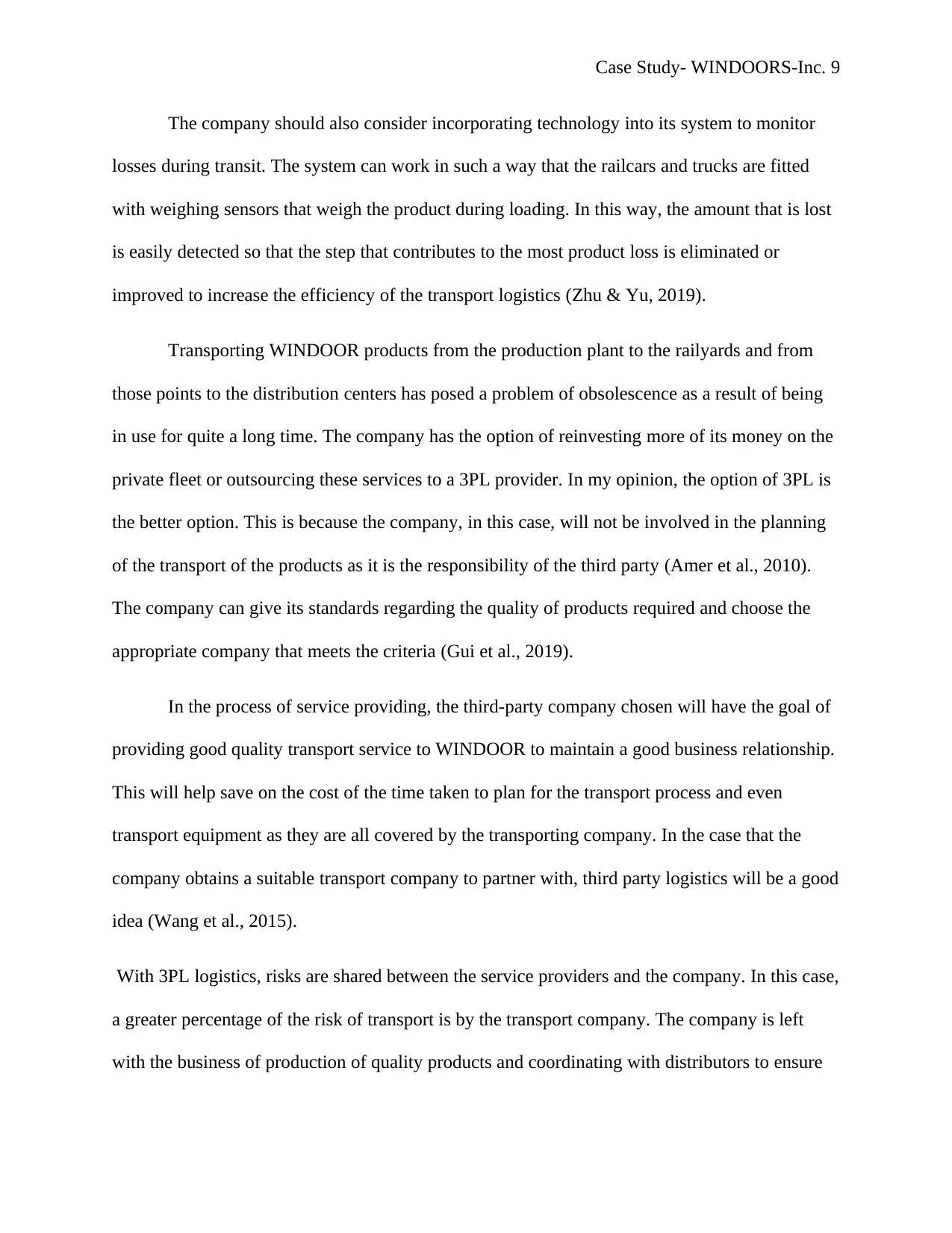
Case Study- WINDOORS-Inc. 9
The company should also consider incorporating technology into its system to monitor
losses during transit. The system can work in such a way that the railcars and trucks are fitted
with weighing sensors that weigh the product during loading. In this way, the amount that is lost
is easily detected so that the step that contributes to the most product loss is eliminated or
improved to increase the efficiency of the transport logistics (Zhu & Yu, 2019).
Transporting WINDOOR products from the production plant to the railyards and from
those points to the distribution centers has posed a problem of obsolescence as a result of being
in use for quite a long time. The company has the option of reinvesting more of its money on the
private fleet or outsourcing these services to a 3PL provider. In my opinion, the option of 3PL is
the better option. This is because the company, in this case, will not be involved in the planning
of the transport of the products as it is the responsibility of the third party (Amer et al., 2010).
The company can give its standards regarding the quality of products required and choose the
appropriate company that meets the criteria (Gui et al., 2019).
In the process of service providing, the third-party company chosen will have the goal of
providing good quality transport service to WINDOOR to maintain a good business relationship.
This will help save on the cost of the time taken to plan for the transport process and even
transport equipment as they are all covered by the transporting company. In the case that the
company obtains a suitable transport company to partner with, third party logistics will be a good
idea (Wang et al., 2015).
With 3PL logistics, risks are shared between the service providers and the company. In this case,
a greater percentage of the risk of transport is by the transport company. The company is left
with the business of production of quality products and coordinating with distributors to ensure
The company should also consider incorporating technology into its system to monitor
losses during transit. The system can work in such a way that the railcars and trucks are fitted
with weighing sensors that weigh the product during loading. In this way, the amount that is lost
is easily detected so that the step that contributes to the most product loss is eliminated or
improved to increase the efficiency of the transport logistics (Zhu & Yu, 2019).
Transporting WINDOOR products from the production plant to the railyards and from
those points to the distribution centers has posed a problem of obsolescence as a result of being
in use for quite a long time. The company has the option of reinvesting more of its money on the
private fleet or outsourcing these services to a 3PL provider. In my opinion, the option of 3PL is
the better option. This is because the company, in this case, will not be involved in the planning
of the transport of the products as it is the responsibility of the third party (Amer et al., 2010).
The company can give its standards regarding the quality of products required and choose the
appropriate company that meets the criteria (Gui et al., 2019).
In the process of service providing, the third-party company chosen will have the goal of
providing good quality transport service to WINDOOR to maintain a good business relationship.
This will help save on the cost of the time taken to plan for the transport process and even
transport equipment as they are all covered by the transporting company. In the case that the
company obtains a suitable transport company to partner with, third party logistics will be a good
idea (Wang et al., 2015).
With 3PL logistics, risks are shared between the service providers and the company. In this case,
a greater percentage of the risk of transport is by the transport company. The company is left
with the business of production of quality products and coordinating with distributors to ensure
⊘ This is a preview!⊘
Do you want full access?
Subscribe today to unlock all pages.

Trusted by 1+ million students worldwide
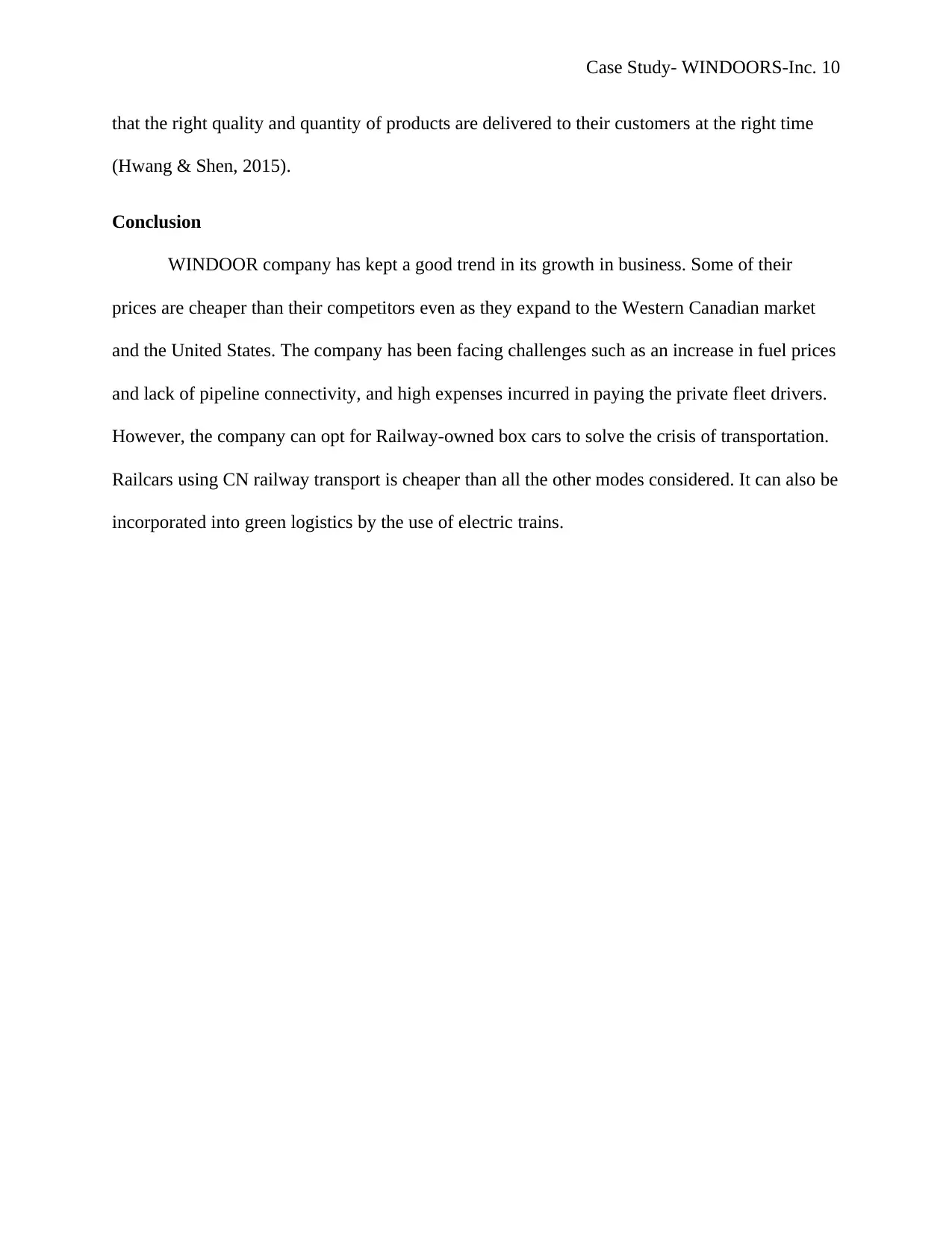
Case Study- WINDOORS-Inc. 10
that the right quality and quantity of products are delivered to their customers at the right time
(Hwang & Shen, 2015).
Conclusion
WINDOOR company has kept a good trend in its growth in business. Some of their
prices are cheaper than their competitors even as they expand to the Western Canadian market
and the United States. The company has been facing challenges such as an increase in fuel prices
and lack of pipeline connectivity, and high expenses incurred in paying the private fleet drivers.
However, the company can opt for Railway-owned box cars to solve the crisis of transportation.
Railcars using CN railway transport is cheaper than all the other modes considered. It can also be
incorporated into green logistics by the use of electric trains.
that the right quality and quantity of products are delivered to their customers at the right time
(Hwang & Shen, 2015).
Conclusion
WINDOOR company has kept a good trend in its growth in business. Some of their
prices are cheaper than their competitors even as they expand to the Western Canadian market
and the United States. The company has been facing challenges such as an increase in fuel prices
and lack of pipeline connectivity, and high expenses incurred in paying the private fleet drivers.
However, the company can opt for Railway-owned box cars to solve the crisis of transportation.
Railcars using CN railway transport is cheaper than all the other modes considered. It can also be
incorporated into green logistics by the use of electric trains.
Paraphrase This Document
Need a fresh take? Get an instant paraphrase of this document with our AI Paraphraser
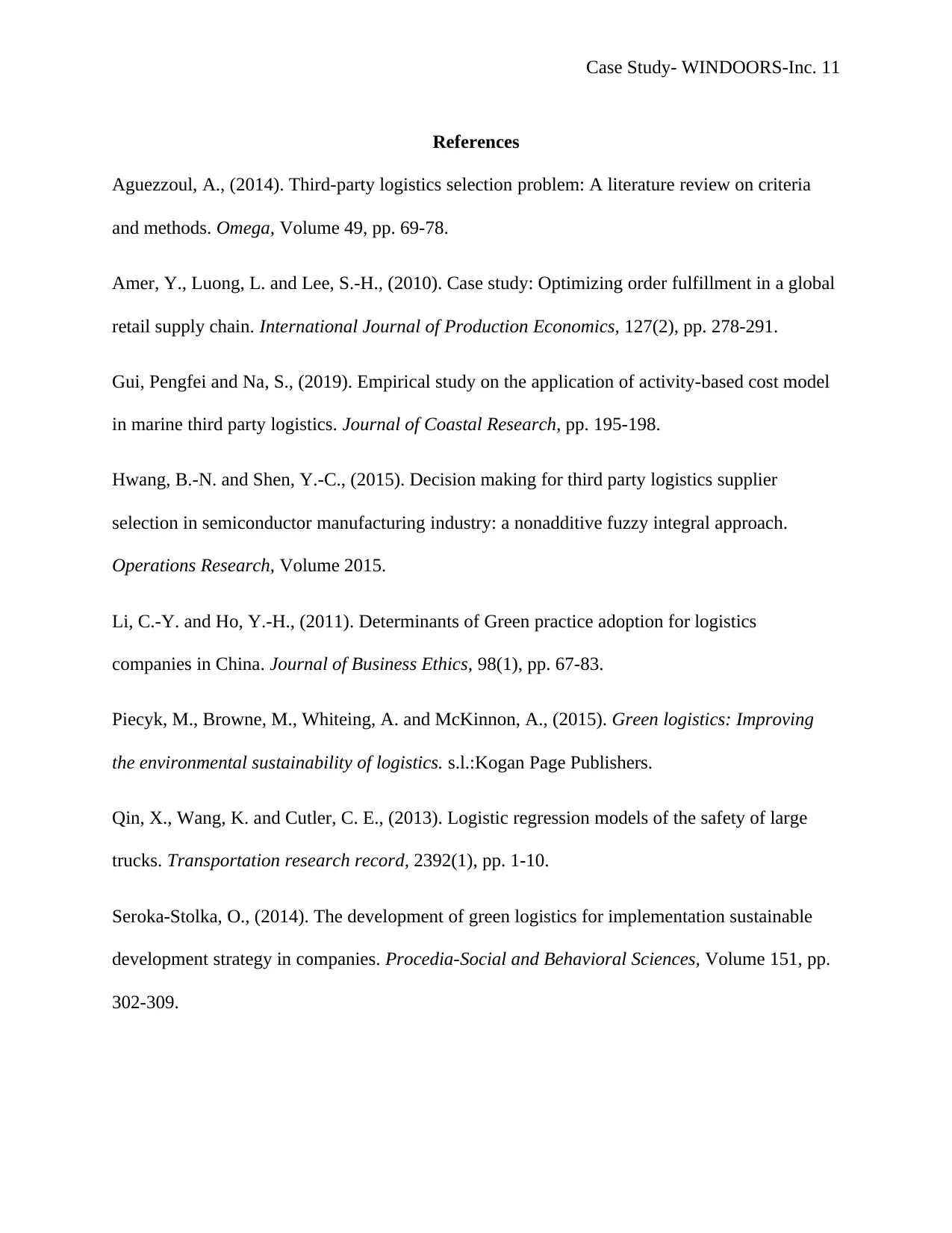
Case Study- WINDOORS-Inc. 11
References
Aguezzoul, A., (2014). Third-party logistics selection problem: A literature review on criteria
and methods. Omega, Volume 49, pp. 69-78.
Amer, Y., Luong, L. and Lee, S.-H., (2010). Case study: Optimizing order fulfillment in a global
retail supply chain. International Journal of Production Economics, 127(2), pp. 278-291.
Gui, Pengfei and Na, S., (2019). Empirical study on the application of activity-based cost model
in marine third party logistics. Journal of Coastal Research, pp. 195-198.
Hwang, B.-N. and Shen, Y.-C., (2015). Decision making for third party logistics supplier
selection in semiconductor manufacturing industry: a nonadditive fuzzy integral approach.
Operations Research, Volume 2015.
Li, C.-Y. and Ho, Y.-H., (2011). Determinants of Green practice adoption for logistics
companies in China. Journal of Business Ethics, 98(1), pp. 67-83.
Piecyk, M., Browne, M., Whiteing, A. and McKinnon, A., (2015). Green logistics: Improving
the environmental sustainability of logistics. s.l.:Kogan Page Publishers.
Qin, X., Wang, K. and Cutler, C. E., (2013). Logistic regression models of the safety of large
trucks. Transportation research record, 2392(1), pp. 1-10.
Seroka-Stolka, O., (2014). The development of green logistics for implementation sustainable
development strategy in companies. Procedia-Social and Behavioral Sciences, Volume 151, pp.
302-309.
References
Aguezzoul, A., (2014). Third-party logistics selection problem: A literature review on criteria
and methods. Omega, Volume 49, pp. 69-78.
Amer, Y., Luong, L. and Lee, S.-H., (2010). Case study: Optimizing order fulfillment in a global
retail supply chain. International Journal of Production Economics, 127(2), pp. 278-291.
Gui, Pengfei and Na, S., (2019). Empirical study on the application of activity-based cost model
in marine third party logistics. Journal of Coastal Research, pp. 195-198.
Hwang, B.-N. and Shen, Y.-C., (2015). Decision making for third party logistics supplier
selection in semiconductor manufacturing industry: a nonadditive fuzzy integral approach.
Operations Research, Volume 2015.
Li, C.-Y. and Ho, Y.-H., (2011). Determinants of Green practice adoption for logistics
companies in China. Journal of Business Ethics, 98(1), pp. 67-83.
Piecyk, M., Browne, M., Whiteing, A. and McKinnon, A., (2015). Green logistics: Improving
the environmental sustainability of logistics. s.l.:Kogan Page Publishers.
Qin, X., Wang, K. and Cutler, C. E., (2013). Logistic regression models of the safety of large
trucks. Transportation research record, 2392(1), pp. 1-10.
Seroka-Stolka, O., (2014). The development of green logistics for implementation sustainable
development strategy in companies. Procedia-Social and Behavioral Sciences, Volume 151, pp.
302-309.
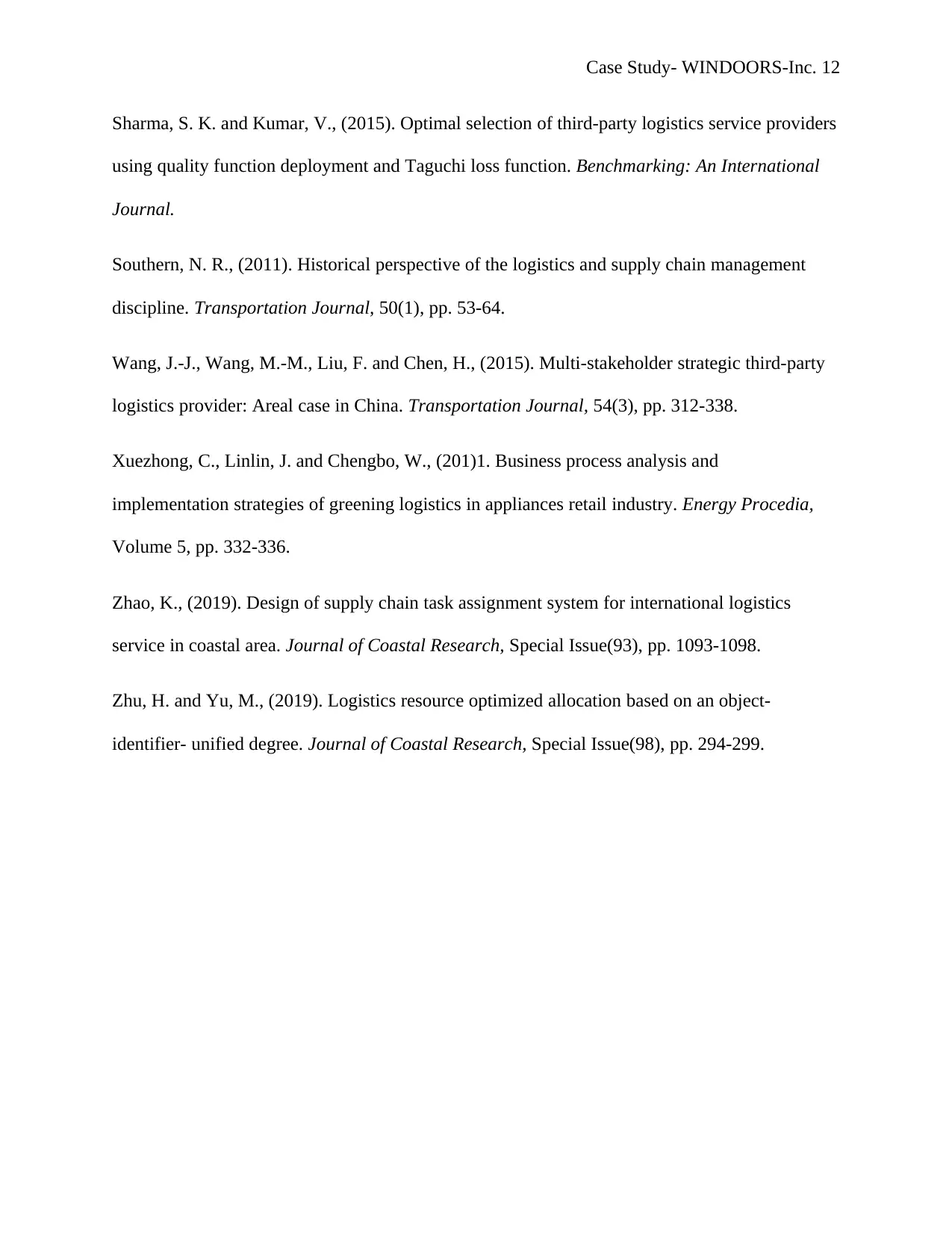
Case Study- WINDOORS-Inc. 12
Sharma, S. K. and Kumar, V., (2015). Optimal selection of third-party logistics service providers
using quality function deployment and Taguchi loss function. Benchmarking: An International
Journal.
Southern, N. R., (2011). Historical perspective of the logistics and supply chain management
discipline. Transportation Journal, 50(1), pp. 53-64.
Wang, J.-J., Wang, M.-M., Liu, F. and Chen, H., (2015). Multi-stakeholder strategic third-party
logistics provider: Areal case in China. Transportation Journal, 54(3), pp. 312-338.
Xuezhong, C., Linlin, J. and Chengbo, W., (201)1. Business process analysis and
implementation strategies of greening logistics in appliances retail industry. Energy Procedia,
Volume 5, pp. 332-336.
Zhao, K., (2019). Design of supply chain task assignment system for international logistics
service in coastal area. Journal of Coastal Research, Special Issue(93), pp. 1093-1098.
Zhu, H. and Yu, M., (2019). Logistics resource optimized allocation based on an object-
identifier- unified degree. Journal of Coastal Research, Special Issue(98), pp. 294-299.
Sharma, S. K. and Kumar, V., (2015). Optimal selection of third-party logistics service providers
using quality function deployment and Taguchi loss function. Benchmarking: An International
Journal.
Southern, N. R., (2011). Historical perspective of the logistics and supply chain management
discipline. Transportation Journal, 50(1), pp. 53-64.
Wang, J.-J., Wang, M.-M., Liu, F. and Chen, H., (2015). Multi-stakeholder strategic third-party
logistics provider: Areal case in China. Transportation Journal, 54(3), pp. 312-338.
Xuezhong, C., Linlin, J. and Chengbo, W., (201)1. Business process analysis and
implementation strategies of greening logistics in appliances retail industry. Energy Procedia,
Volume 5, pp. 332-336.
Zhao, K., (2019). Design of supply chain task assignment system for international logistics
service in coastal area. Journal of Coastal Research, Special Issue(93), pp. 1093-1098.
Zhu, H. and Yu, M., (2019). Logistics resource optimized allocation based on an object-
identifier- unified degree. Journal of Coastal Research, Special Issue(98), pp. 294-299.
⊘ This is a preview!⊘
Do you want full access?
Subscribe today to unlock all pages.

Trusted by 1+ million students worldwide
1 out of 12
Related Documents
Your All-in-One AI-Powered Toolkit for Academic Success.
+13062052269
info@desklib.com
Available 24*7 on WhatsApp / Email
![[object Object]](/_next/static/media/star-bottom.7253800d.svg)
Unlock your academic potential
Copyright © 2020–2025 A2Z Services. All Rights Reserved. Developed and managed by ZUCOL.



